1864
Repeatability of apparent diffusion coefficient and intravoxel incoherent motion parameters at 3.0 Tesla in orbital masses.Augustin Lecler1, Julien Savatovsky1, and Laure Fournier2
1Radiology, Fondation Ophtalmologique Adolphe de Rothschild, Paris, France, 2Radiology, Hôpital Européen Georges Pompidou, Paris, France
Synopsis
- IVIM technique is feasible in the orbit with a good to acceptable repeatability of ADC and D. (coefficient of variation range 12%-25%) - Interobserver repeatability agreement is excellent for all the IVIM parameters in the orbit. (intraclass correlation coefficient range 90-95%) - The use of PF or D* as biomarkers should be cautious because of high test-retest and interobserver variabilities.
Introduction
Intravoxel incoherent motion (IVIM) has been shown to provide a pertinent description of the Diffusion Weighted (DW) signal measured in highly vascular organs1. In the orbit, a few studies showed that a restricted diffusion in orbital tumors during MR imaging with DW imaging could predict malignancy2–4, but no study has previously evaluated the performances of IVIM imaging on orbital diseases. Before evaluating the interest of IVIM in clinical practice, we tried to evaluate the repeatability of its parameters in the orbit.Methods:
This prospective study was approved by the Institutional Review Board and signed informed consent was obtained from all participants. From December 2015 to March 2016, twenty-two patients were scanned twice using an IVIM with 15b values (0-2000 s.mm²) at 3.0T. Two readers independently delineated regions of interest in an orbital mass and in different intra orbital (lacrymal gland, medial and lateral extrao-cular muscles) and extra-orbital (i.e. temporal muscle, temporal lobe) structures. Short-term test-retest repeatability and inter-observer agreement were assessed using the intra-class correlation coefficient (ICC), the coefficient of variation (CV), and Bland-Altman limits of agreements (BA-LA).Results:
Test-retest repeatability of IVIM parameters in the orbital mass was satisfactory for ADC and D (mean CV 12% and 14%, ICC 95% and 93%, BA-LA : [-0.35; 0.35] and [-0.36; 0.27])poor for PF and D*(means CV 43% and 110%, ICC 90% and 65%, BA-LA: [-0.10; 0.10] and [-23.1; 20.9]). Inter-observer repeatability agreement was almost perfect in the orbital mass for all the IVIM parameters (ICC = 95%, 93%, 94% and 90% and BA-LA = [-0.30; 0.29], [-0.26; 0.27], [-0.06; 0.07] and [-10.5; 8.6] for ADC, D, PF and D* respectively).Discussion :
Our study showed the feasibility and good repeatability of quantitative assessment of IVIM parameters in the orbit. The IVIM is a relatively new imaging technique and seems promising in the characterization and evaluation of tumors, but there are relatively few studies evaluating its accuracy, repeatability or reproducibility. We carefully followed the Quantitative Imaging Biomarkers Alliance (QIBA) guidelines5,6 to conduct our study because we believe that the development and implementation of new quantitative imaging biomarkers such as the IVIM values should not suffer from inconsistent or incorrect use of terminology or methods for technical performance and statistical concepts. Only a few studies evaluated the interest of the DWI in the orbit, but they showed its usefulness when visualizing and diagnosing orbital tumors. A low ADC was reported to have good accuracy in distinguishing benign from malignant orbital lymphoproliferative disorders3 and a recent study combining morphological characteristics to DWI and dynamic contrast-enhanced perfusion showed that ADC alone yielded the optimal sensitivity in differentiating malignant from benign orbital lymphoproliferative disorders4. Therefore, acquisition of IVIM parameters could potentially be useful in the characterization of orbital masses, as more quantitative DWI parameters are acquired, some of them eventually reflecting tissular perfusion. In our study, D values were systematically lower than the ADC values with a clear linearity among the ROI between these two values, strongly supporting the existence of a diffusional component in the orbital tumors which could be evaluated by the D value, as well as a non-negligible perfusional component, which could be evaluated with the PF and D*. Both ADC and D showed a good repeatability in our study, suggesting that the D value might be a reliable and reproducible quantitative biomarker and could serve as a potential biomarker to characterize orbital tumors, to quantify the severity of the disease and to predict the disease course, but also to evaluate therapeutic responses under treatments like chemotherapy for lymphomas or prototherapy for ocular melanomas.Conclusion:
IVIM appeared to be an appropriate tool to measure orbital masses with good test-retest repeatability of ADC and D, but this approach showed poor repeatability of PF and D*.Acknowledgements
No acknowledgement found.References
1. Koh, D.-M., Collins, D. J. & Orton, M. R. Intravoxel incoherent motion in body diffusion-weighted MRI: reality and challenges. AJR Am. J. Roentgenol. 196, 1351–1361 (2011). 2. Sepahdari, A. R. et al. Indeterminate orbital masses: restricted diffusion at MR imaging with echo-planar diffusion-weighted imaging predicts malignancy. Radiology 256, 554–564 (2010). 3. Haradome, K. et al. Orbital lymphoproliferative disorders (OLPDs): value of MR imaging for differentiating orbital lymphoma from benign OPLDs. AJNR Am. J. Neuroradiol. 35, 1976–1982 (2014). 4. Xu, X.-Q. et al. Benign and malignant orbital lymphoproliferative disorders: Differentiating using multiparametric MRI at 3.0T. J. Magn. Reson. Imaging JMRI (2016). doi:10.1002/jmri.25349 5. Raunig, D. L. et al. Quantitative imaging biomarkers: a review of statistical methods for technical performance assessment. Stat. Methods Med. Res. 24, 27–67 (2015). 6. Sullivan, D. C. et al. Metrology Standards for Quantitative Imaging Biomarkers. Radiology 277, 813–825 (2015).Figures
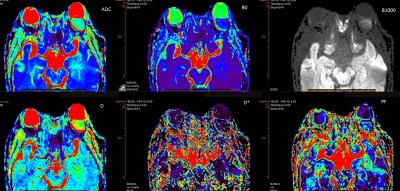
Parametric IVIM maps
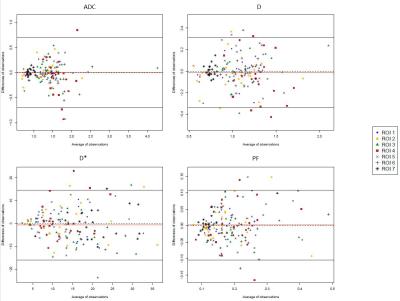
Bland-Altman plots showing test-retest repeatability of ADC, D, D*, PF for all ROI.
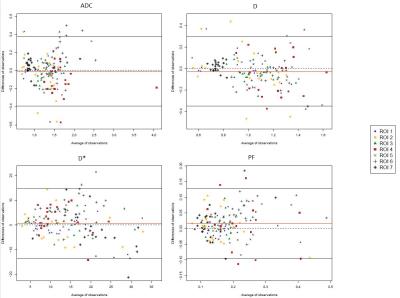
Bland-Altman plots showing inter-observer repeatability agreement of ADC, D, D*, PF for all ROI.
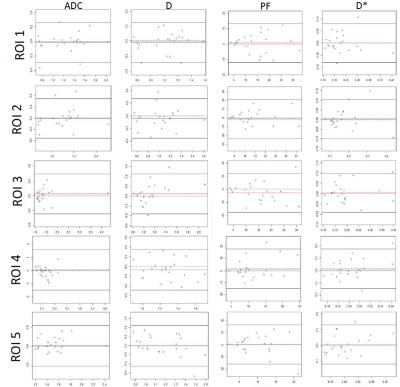
Bland-Altman plots showing test-retest repeatability agreement of
ADC, D, D*, PF in the orbital mass (ROI 1 and 2) and in the lacrymal gland and extra-ocular
muscles (ROI 3, 4, 5)
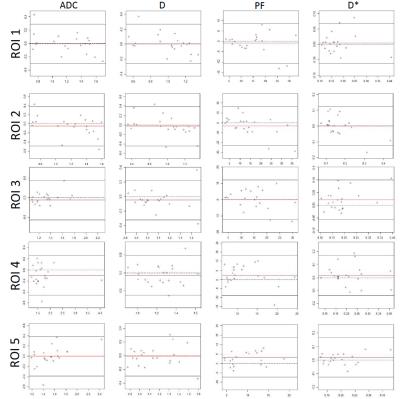
Bland-Altman plots showing inter-observer repeatability agreement of
ADC, D, D*, PF in the orbital mass (ROI 1 and 2) and in the lacrymal gland and extra-ocular
muscles (ROI 3, 4, 5)